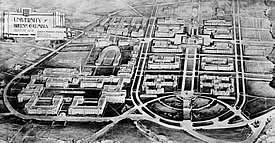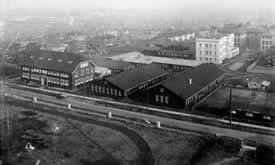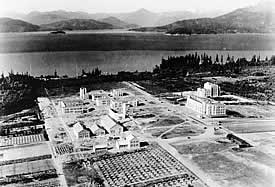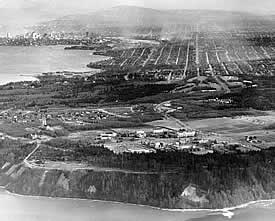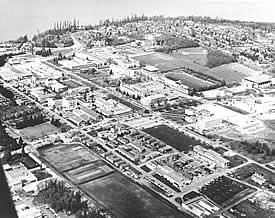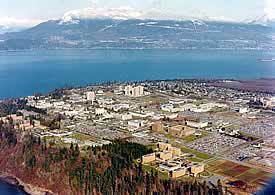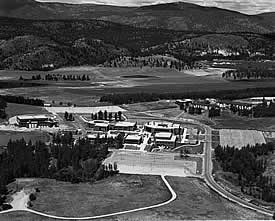- Pre-contact
-
- (UBC-V) What is now the site of UBC-Vancouver's Point Grey campus is inhabited by Coast Salish peoples, in particular the Musqueam First Nation. Point Grey is known as ?əlqsən (Ulksun). The Squamish and Tsleil-Waututh First Nations also make use of the land and its resources.
- (UBC-O) The future site of UBC-Okanagan's Kelowna campus is inhabited by the Syilx (Okanagan) Peoples.
- ca. 1860
- Point Grey established by British government as a Colonial Admiralty reserve - presumably for strategic reasons relating to protecting English Bay and the Fraser River estuary.
- 1865
- 21-year timber lease on Point Grey granted to Vancouver Island Spar, Lumber and Sawmill Company Limited (later Hastings Sawmill Company)
- 1877
- Initial proposal for a provincial university made by Superintendent of Education John Jessop, only six years after British Columbia joined Canada, with the total population still less than 50,000.
- 1890
- An Act Respecting the University of British Columbia passed by the provincial legislature. However, the political rivalry between Vancouver Island and the mainland leads to a dispute about where the university should be located.
- 1891
- The first meeting of the new university's senate in Victoria (Vancouver Island) fails to reach quorum when some members from the mainland fail to attend. A second meeting is never held, and the Act is allowed to lapse.
- 1899
- Vancouver High School establishes Vancouver College, affiliated with Montreal's McGill University.
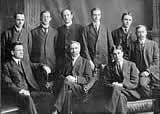
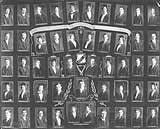 1906
1906- Vancouver College is taken over by McGill and renamed McGill University College of British Columbia (group photograph of faculty, left; class picture of Arts '16, right). McGill University College offers only two-year programmes in arts and sciences; students still have to go elsewhere to complete their degrees.
- 1907
- University Endowment Act provides for the funding of a provincial university through the sale of up to two million acres of Crown land in central and northern British Columbia.
- 1908
- Provincial legislature passes a new University Act establishing the University of British Columbia. It provides for a Chancellor, a Convocation, a President, a Board of Governors to manage the University's administrative, property, and business affairs, and a Senate to administer academic matters. Convocation is initially to include all graduates of British or Canadian universities resident in the province, plus 25 members chosen by the provincial government; after its first meeting, it is to consist of members of the first Convocation, plus members of Senate and all graduates of the University. The "Act" also declares the University to be non-sectarian and co-educational.
- 1910
- After a province-wide survey, Point Grey, near Vancouver, is selected as the site of the UBC campus.
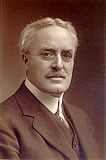 1912
1912-
- First meeting of Convocation. Election of Dr. Francis Carter-Cotton, head of MUCBC, as first Chancellor.
- "Bowser-Hughes Agreement": Dominion government agrees to cede all "right, title, and interest" in the Point Grey reserve established in the 1860s (see above) to the provincial government, in exchange for the right to build a drill hall and parade ground, a wireless station, and a coastal artillery battery. This clears the way for the UBC campus to be built on the site.
- 1913
-
- Dr. Frank Fairchild Wesbrook (right) appointed first President of UBC.
- Architectural firm of Sharp and Thompson (later Thompson, Berwick, Pratt and Partners) appointed University Architects, after winning a campus planning and design competition.
- 1914
-
- Construction of first permanent buildings at Point Grey begins. Outbreak of First World War halts work the next year, with only land-clearance and the frame of the Science Building completed.
- Librarian J.T. Gerould from the University of Minnesota, hired to purchase books in Europe, is arrested as a spy in Leipzig, Germany when war breaks out; the incriminating "evidence" is a copy of the UBC site plan in his baggage.
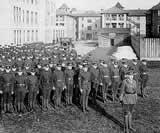
- 1915
-
- University of British Columbia opens in temporary headquarters at the former McGill University College facilities adjacent to Vancouver General Hospital (nicknamed the Fairview "shacks" after the surrounding neighbourhood). There are three faculties: Arts, Applied Science, and Agriculture. Student enrolment in September is 379. Full- and part-time faculty number 34.
- Alma Mater Society (student union) formed.
- Military training included in curriculum for duration of the war (right). By the end of the First World War, 697 students would see active military service – 78 would be killed in action.
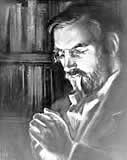 1916
1916- John Ridington (left) appointed first University Librarian.
- 1918
- President Wesbrook dies, and is succeeded the following year by Dean of Agriculture Dr. Leonard S. Klinck.
- 1919
- The return of students from war-time duty increases enrolment to 890 for 1919-20. The "shacks" quickly become over-crowded, with classes being held in tents, churches, and Sunday schools; however, construction at Point Grey is not resumed.
- The University offers first degree programme in nursing in the British Empire.
- 1920
-
- Victoria College opens in affiliation with UBC.
- The University imposes first tuition fees of $40 per year.
- "University Endowment Act" amended: rights to Crown lands in the interior exchanged for 3000 acres adjacent to the Point Grey site, which are intended for sale as residential properties.
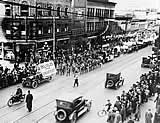 1922
1922- Tired of over-crowded conditions (full-time enrolment reaches 1200 for 1921-22), students organize province-wide publicity campaign to persuade the government to complete the Point Grey campus. The "Build the University" campaign climaxes in a parade (the "Great Trek") from downtown Vancouver (right) to Point Grey, and the presentation of a petition with 56,000 signatures to the Speaker of the Legislature in Victoria. The government authorizes a $1.5 million loan to resume construction. The campaign marks the beginning of active student involvement in the University's development.
- 1923
- Government lets contracts for completion of Point Grey buildings: the Science building (today part of the Chemistry building), the Library, a power plant, and nine "semi-permanent" buildings (Arts, Agriculture, Applied Science, Administration, the Auditorium, and four laboratory/workshop buildings, most of which are still in use today).
- 1925
-
- UBC opens its Point Grey campus. As part of the inauguration ceremonies, the University holds a special Congregation to award its first honorary degrees.
- 1929
- The first gymnasium, built with funds raised by students, is presented to the University.
- 1932
- Great Depression forces reduction in University operating grants by provincial government. Students mount successful publicity campaign against a suggestion that the University be closed; however, the budget is reduced from $626,000 to $250,000 and salaries are reduced. The resulting disputes between President Klinck, the Board, and the Senate eventually lead to amendments to the University Act in 1935 which re-organizes the University government.
- 1934
- UBC athletic teams adopt the nickname "Thunderbirds".
- 1936
- Establishment of Department of University Extension (today's Continuing Studies), which provides post-secondary education around the province and year-round.
- 1937
- Students contribute funds toward construction of UBC Stadium.
- 1939
-
- Enrolment reaches 2400 students.
- Registration in campus C.O.T.C. (Canadian Officer Training Corps) unit doubles as Second World War begins. A total of 1680 students would eventually enlist in the armed services. Of that total, 169 would "make the ultimate sacrifice", including R. Hampton "Hammy" Gray, posthumously awarded the Victoria Cross.
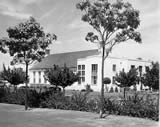 1940
1940- Students contribute to the construction of the first student union building, Brock Hall (right).
- 1941
-
- Students waive army pay to help construct Armoury. Campus army unit reaches maximum strength of 1879, and many faculty members are on leave for special war-time duty.
- Federal government funding for defence and other research purposes increases.
- 1944
-
- Dr. Norman A.M. MacKenzie appointed UBC's third President.
- First student residences opened at Acadia and Fort Camps.
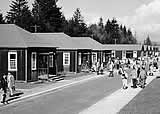 1945
1945- University begins a period of post-war academic expansion by inaugurating the Faculty of Law, and establishing new programmes in social work, pharmacy, home economics, and physical education. To accomodate the new programmes and expanding enrolment, fifteen abandoned army and air force camps are dismantled and shipped to Point Grey, where the huts serve as classrooms, laboratories, and residences for both students and faculty. A few are still in use today, mainly for storage purposes (left).
- 1947
-
- Enrolment swells to 9374, with war veterans making up some 50 percent.
- Postwar construction would add more than twenty new buildings by 1951, including facilities for physics, engineering, and biological sciences, as well as the Library's north wing.
- Opening of the first Faculty Club, in a surplus army hut originally used as an officers' mess.
- 1948
-
- Van de Graff atomic generator installed in Hennings (Physics) Building – one of many government-supported post-war research initiatives.
- During half-time at the UBC Homecoming football game, Chief William Scow, on behalf of the Kwicksutaineuk people, officially sanctioned the use of the name "Thunderbird" for the University's athletic teams and facilities. During the ceremony, native carvers Ellen and Ted Neal presented a twenty-two foot totem pole which served to sanctify the occasion.
- 1949
-
- Faculties of Pharmacy and Medicine established.
- Faculty of Graduate Studies established to administer masters and Ph.D. programmes.
- First Museum of Anthropology opened in the basement of the Library.
- 1950
- Schools of Commerce and Education established.
- 1951
-
- Student initiative leads to construction of War Memorial Gymnasium, as a memorial to British Columbia's war dead. Mounted in the gymnasium are plaques of the University's "honour rolls" – lists of students who lost their lives in the two World Wars.
- First women's residences opened.
- Faculty of Forestry – formerly a department in Applied Science – established, along with the School of Nursing.
- 1954
-
- British Empire Games swimming and diving events held at newly-constructed pool adjacent to War Memorial Gymnasium.
- Brock Hall partially destroyed by fire. Restoration funded by donations from students and alumni.
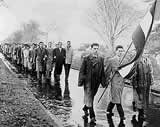 1956
1956-
- Construction of Buchanan Building for Faculty of Arts and Science begins.
- Schools of Commerce and Education promoted to Faculty status.
- UBC incorporates the Sopron School of Forestry from Hungary, after students and faculty flee their homeland in the wake of the failed anti-Soviet revolution of 1956 (shown at 1957 memorial service, right). They formed the Sopron Division of the Faculty of Forestry, with their own curriculum taught primarily in Hungarian.
- 1958
- University celebrates its "Golden Jubilee" and launches the "UBC Development Fund", the first public appeal for capital funds by any Canadian university. Fund drive and government contributions together raise $35 million.
- 1959
-
- International House, a meeting place for UBC students from outside Canada, officially opened by Eleanor Roosevelt.
- Opening of new Faculty Club and University Social Centre, donated by Leon and Thea Koerner.
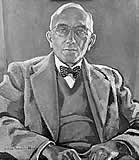 1960
1960-
- Construction of the Library's south wing, made possible by a substantial gift from Walter C. Koerner, completed, housing an undergraduate library (later named the Sedgewick Library, after former English Department head and Shakespearean scholar Garnett G. Sedgewick, right) and a Special Collections Division.
- Dr. William Holland arrives to head the new Department of Asian Studies, bringing with him the library and records of the Institute of Pacific Relations, which had closed its New York office in the wake of allegations of Communist influence.
- 1961
- Schools of Librarianship and Rehabilitation Medicine open.
- 1962
- Dr. John B. Macdonald becomes UBC's fourth President.
- 1963
-
- Report by President Macdonald on the future of higher education in British Columbia. A new university and a network of community colleges are among the recommendations.
- Provincial government passes new Universities Act, which provides for the incorporation of the University of Victoria (formerly Victoria College) and Simon Fraser University.
- 1964
-
- A gift of $3.5 million by Dr. P.A. Woodward assures continuing development of UBC's Health Sciences Centre, including classroom facilities, a bio-medical library, and a hospital.
- Faculty of Arts and Science splits.
- First class enrols in new Faculty of Dentistry.
- 1965
-
- Forestry magnate H.R. MacMillan gives $3 million to expand Library book collection. This coincides with the decentralization of Library system, eventually leading to establishment of thirteen branch libraries around the campus and elsewhere in Vancouver, housing over three million books.
- University begins largest expansion programme in its history, building South Campus research area.
- (UBC-O) Based on the recommendations of the Macdonald Report, Okanagan College opens its first campus in Kelowna. Other campuses would later be established in Penticton, Vernon, and Salmon Arm.
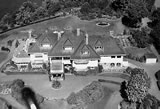 1967
1967-
- First four students elected to University Senate.
- "Yorkeen" mansion, at north end of campus, purchased by Cecil Green (former UBC student and co-founder of Texas Instruments) and donated to the University. Renamed Cecil Green Park House (right), today it houses the University's Development Office and the UBC Alumni Association.
- 1968
-
- New Student Union Building (SUB) completed. Brock Hall turned over to student services and administration.
- American "Yippie" leader Jerry Rubin leads student sit-in at UBC Faculty Club. Occupation ends without violence 22 hours later.
- (UBC-O) Okanagan College begins offering university transfer courses.
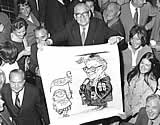 1969
1969- Popular University alumnus, mathematics professor, and administrator Dr. Walter H. Gage (left) appointed President.
- 1970
- UBC enrolment numbers 20,936 students.
- 1971
- UBC becomes first university in Canada to offer Women's Studies programme for academic credit.
- 1972
- UBC Senate adopts report advocating new emphasis on opportunities for part-time degree study.
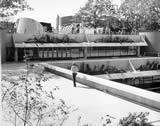 1973
1973-
- Sedgewick Undergraduate Library moves to underground facilities west of Main Library (right).
- Investment in UBC buildings from 1915 to 1973 totals more than $173 million.
- Senate approves recommendations for election of 196 students as full voting members of UBC's twelve faculties.
- Enrolment in credit and non-credit programmes at Point Grey and throughout British Columbia totals 66,508 students.
- 1974
-
- Senate committee proposes priorities for 16 building projects, costing an estimated $35 million, for period 1975-1980.
- Tri-University Meson Facility (TRIUMF) opened in South Campus area, housing giant cyclotron used for research in nuclear and particle physics.
- 1975
- Former Dean of Arts Dr. Douglas T. Kenny appointed President of UBC.
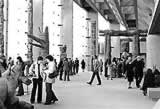
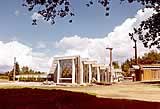 1976
1976-
- Opening of the new Museum of Anthropology, designed by famed Canadian architect Arthur Erickson. Partially funded by the Canadian government, the Museum features outstanding collections of Northwest Coast First Nations art (interior and exterior views, left).
- Establishment of Centre for Human Settlements at UBC, in connection with the United Nations Conference on Human Settlement (Habitat '76) in Vancouver.
- 1977
- UBC begins teacher education programme in Whitehorse, Yukon Territory.
- 1979
- UBC awards its 100,000th degree.
- 1980
- Final phase of Health Sciences Centre opens. The Koerner Pavilion, named for Walter C. Koerner, includes an Acute Care Hospital.
 1981
1981-
- Opening of Asian Centre (right), which houses the Department of Asian Studies and an Asian Library, and which is adjacent to the classical Japanese Nitobe Memorial Garden.
- Discovery Park UBC established in South Campus area, on land leased to the provincial government for use as a research facility.
- 1982
- A University budget shortfall of $7.5 million, and provincial government's refusal to provide additional funding, forces UBC to raise tuition fees an average of 32.8%, and consider cutting faculty and support staff. Student protests, including a campus-wide "day of mourning", have little effect.
- 1983
- Dr. K. George Pederson appointed President.
- 1984
- Faced with continuing financial constraints, Senate votes to limit first-year enrolment for 1984-85, and the Board of Governors raises tuition fees an average of 33%.
- 1985
- President Pederson resigns in protest against provincial government cuts in post-secondary funding. Dr. Robert H.T. Smith appointed President pro tem. Later in the year, Dr. David W. Strangway is named University President.
- 1986
- Provincial government announces "Fund for Excellence In Education", to be shared by all three provincial universities to support "Centres of Excellence" in certain areas of research and instruction.
 1988
1988-
- UBC Real Estate Corporation (now UBC Properties Trust) founded to develop the University's real estate assets, for capital fund or endowment purposes. Its first project is Hampton Place, a residential development near the south end of campus (architectural rendering, left). It would later plan and develop a series of residential neighbourhoods around the campus, collectively known as "University Town".
- Computerized telephone course registration system, known as TELEREG, introduced. This replaces the on-campus "arena scheduling" system, which required students to physically walk across campus from department to department to register for courses.
- 1989
-
- Launching of "The UBC Campaign", with its theme "A World of Opportunity". Its goal is to raise $66 million in private and corporate donations, with the provincial government to provide equal matching funds, to pay for new buildings, facilities, programmes, and scholarships. Overwhelmingly successful, by the time it ends in 1993 the campaign will have raised a total of $262 million.
- Pacific Spirit Regional Park created from undeveloped areas of University Endowment Lands.
- (UBC-O) UBC enters into partnership with Okanagan College and Cariboo College (Kamloops), allowing the Colleges to provide third- and fourth-year courses leading to degrees in Arts and Science. Similar arrangements are made between Okanagan College and the University of Victoria regarding courses in education and nursing. The first degrees under this arrangement would be granted by Okanagan College in the name of UBC in 1991.
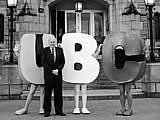 1990
1990- UBC celebrates the 75th anniversary of its opening with a series of special events, including the largest Open House in its history (President David Strangway with "letter people" mascots, right).
- 1992
-
- Undergraduate and graduate enrolment for the 1992-93 academic year totals 30,579 students. Registration for non-credit courses exceeds 85,000. Full-time faculty number 1851, and support staff number 3774. Expenses for 1991-92 totalled $328,011,000, and funding for research (both grants and contracts) totalled $116,957,082.
- Release of a new Main Campus Plan, following those of 1959, 1968, and 1982. It is intended to direct the growth and evolution of the Point Grey campus to the year 2000 and beyond.
- Ritsumeikan House opens for students from UBC's exchange programme with Ritsumeikan University in Kyoto, Japan.
- (UBC-O) To reflect its increasing role as a post-secondary institution, Okanagan College informally adopts the name "Okanagan University College" (OUC). The name change would be formalized by provincial legislation in 1995.
- 1993
-
- U.S. President Bill Clinton and Russian President Boris Yeltsin meet at UBC during the "Vancouver Summit".
 Opening of First Nations House of Learning (left). Built of western red cedar, with a copper-clad roof, its design is based on that of a Coast
Salish longhouse. It houses First Nations education programmes, counselling
services, and cultural events, and generally serves as a "home away from
home" for some 250 First Nations students attending UBC.
Opening of First Nations House of Learning (left). Built of western red cedar, with a copper-clad roof, its design is based on that of a Coast
Salish longhouse. It houses First Nations education programmes, counselling
services, and cultural events, and generally serves as a "home away from
home" for some 250 First Nations students attending UBC.- Opening of Green College, a residential graduate college designed to foster an "interdisciplinary community" among visiting scholars and students.
 UBC biochemistry professor Michael Smith (right) receives the Nobel Prize in Chemistry for his pioneering work in the development of "site directed mutagenesis", a technique which allows gene sequences to be altered in a designated manner for use in medical and biological research.
UBC biochemistry professor Michael Smith (right) receives the Nobel Prize in Chemistry for his pioneering work in the development of "site directed mutagenesis", a technique which allows gene sequences to be altered in a designated manner for use in medical and biological research.- (UBC-O) OUC opens its main North Kelowna campus.
- 1995
-
- Opening of C.K. Choi Building, for the Institute of Asian Research. Constructed largely of recycled materials (including timber beams from the demolished Armoury), it embodies the most advanced environmental design principles.
- (UBC-O) The provincial College and Institute Act grants OUC and other regional colleges the authority to grant undergraduate degrees in their own name. OUC would award its first such degrees in 1998.
- 1996
-
- Undergraduate admissions policy revised by Senate, enabling faculties to use criteria such as leadership abilities and career-related work experience for admitting students directly from high school.
- Establishment of St. John's College, a residential graduate college, and the Sing Tao School of Journalism announced. Both would officially open the following year.
- Completion of Walter C. Koerner Central Library, which combines Sedgewick Library with a new five-storey building.
- 1997
-
- Dr. Martha C. Piper appointed UBC's new President.
- The Asia-Pacific Economic Co-operation (APEC) Economic Leaders' Meeting is hosted by the federal government at the UBC Museum of Anthropology. Approximately 1,500 protesters come to the campus to voice their concerns that APEC discussions aimed at liberalizing trade between participating countries would not include any reference to human rights and social and environmental issues. Clashes between protestors and police would lead to a number of legal actions and an official inquiry.
- 1998
-
- First Annual General Meetings held – one in downtown Vancouver, the other on campus. The meetings are intended to inform both the University community and the general public about UBC's goals for the future, key accomplishments of the past year, and its financial position.
- Board of Governors approves Trek 2000, a vision document presenting the University's goals and principles for the 21st century, and identifying key targets and strategies to attain them.
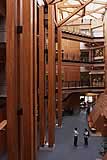 Faculty of Forestry moves from the Macmillan Building, which it
had shared with Agricultural Sciences, to the Forest Sciences Centre (left).
A fundraising campaign, providing opportunities to name certain facilities
in the Forest Sciences Centre, attracted support from the B.C. forest industry,
with UBC providing matching funds.
Faculty of Forestry moves from the Macmillan Building, which it
had shared with Agricultural Sciences, to the Forest Sciences Centre (left).
A fundraising campaign, providing opportunities to name certain facilities
in the Forest Sciences Centre, attracted support from the B.C. forest industry,
with UBC providing matching funds.
- 2000
- Completion of Donald Rix Building, named after the UBC professor of pathology and entrepreneur who contributed to the cost of the building, and built to accommodate companies created on the basis of UBC research. There are 22 private companies located on campus. Most of these are UBC spin-offs, with the remainder having research relationships with the University. Profits from lease agreements with these companies are fed back into UBC research.
- 2001
-
- The Wallace B. Chung and Madeline H. Chung Collection and Reading Room opens in Main Library. Originally donated in 1999, the collection is considered a national treasure and valued in the millions of dollars. It consists of more than 25,000 items and focuses on the exploration of the Pacific Northwest, the Chinese experience in North America, the history of British Columbia, and the Canadian Pacific Railway Company.
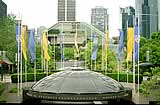 Opening of UBC at Robson Square, located in downtown Vancouver (right).
Both credit and non-credit courses are taught at the new campus, primarily
from Commerce and Continuing Studies. Public lectures in a broad range
of cultural and community themes are also presented. UBC at Robson Square
also houses the Women's Resource Centre, as well as library and bookstore
facilities.
Opening of UBC at Robson Square, located in downtown Vancouver (right).
Both credit and non-credit courses are taught at the new campus, primarily
from Commerce and Continuing Studies. Public lectures in a broad range
of cultural and community themes are also presented. UBC at Robson Square
also houses the Women's Resource Centre, as well as library and bookstore
facilities.- TELEREG course registration system eliminated in favour of an Internet-based system via the UBC Student Services website.
- UBC collaborates with Simon Fraser University, British Columbia Institute of Technology, and Emily Carr Institute of Art and Design to establish Great Northern Way Campus, on land donated by Finning International in the "False Creek Flats" area of Vancouver. GNWC is intended to provide an integrated environment for innovative education and research initiatives in the arts, digital media, and environmental technology.
- 2002
- Completion of the Chapman Learning Commons in the 5th-floor concourse of the Main Library. The Commons features group study space, learning resources, and state-of-the-art computing and Internet facilities.
- 2003
-
- Faculty of Commerce and Business Administration changes its name to Sauder School of Business, to honour a $20 million gift from forest industry leader and former UBC Chancellor William L. Sauder.
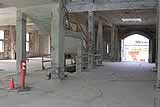 Construction begins on the Irving
K. Barber Learning Centre, to be built around the heritage core of
Main Library (interior during reconstruction, left). It is named
for forest industry leader Irving K. "Ike" Barber, who donated
$20 million for its construction (UBC and the provincial government provided
matching funding), and is intended to house Library collections, academic programmes, and study spaces.
Construction begins on the Irving
K. Barber Learning Centre, to be built around the heritage core of
Main Library (interior during reconstruction, left). It is named
for forest industry leader Irving K. "Ike" Barber, who donated
$20 million for its construction (UBC and the provincial government provided
matching funding), and is intended to house Library collections, academic programmes, and study spaces.
- 2004
-
- Opening of the Michael Smith Laboratories, a $30-million biotechnology research facility at UBC Vancouver, housing the former UBC Biotechnology Laboratory and named after the Nobel Laureate who died in 2000.

 (UBC-O) Announcement of the merger of UBC and Okanagan
University College in March 2004. UBC Okanagan would open on the site of OUC's North Kelowna campus in September
2005 (right) – at the same time, other OUC campuses would be reorganized
to form Okanagan College.
(UBC-O) Announcement of the merger of UBC and Okanagan
University College in March 2004. UBC Okanagan would open on the site of OUC's North Kelowna campus in September
2005 (right) – at the same time, other OUC campuses would be reorganized
to form Okanagan College.- (UBC-O) Board of Governors approves a $18.4 million construction plan for new student residences at UBC Okanagan.
- (UBC-O) Irving K. Barber provides $12.25 million endowment to establish UBC Okanagan's Irving K. Barber School of Arts and Sciences.
- 2005
-
- After a lengthy re-visioning process, the Faculty of Agricultural Sciences is re-named the Faculty of Land and Food Systems "to better reflect the diversity of its academic programs and research initiatives".
- Official launch of revised vision document Trek 2010.
- (UBC-O) Formal transition of OUC to Okanagan College and UBC Okanagan. UBC Okanagan's official opening ceremony is in September.
- (UBC-O) UBC and the Okanagan Nation Alliance sign a Memorandum of Understanding. It established a formal relationship between the University and the Alliance, recognized that the UBC-O campus was located on traditional Okanagan territory, and authorized joint initiatives for First Nations higher educational programmes at UBC-O. The agreement would be renewed in 2012.
- 2006
-
- Dr. Stephen J. Toope is appointed UBC's twelfth president.
- UBC signs Memorandum of Affiliation with the Musqueam First Nation. Similarly to the agreement with the Okanagan Nation Alliance, it established a formal relationship between the University and Musqueam, recognized that the Point Grey campus was located on traditional Musqueam territory, and authorized joint initiatives for First Nations higher educational programmes at UBC.
- UBC institutes a policy of offering Indigenous territorial acknowledgement (e.g. “We acknowledge that the land on which we gather is part of the traditional, ancestral, and unceded territory of the ________ First Nation”) at public events at both the Vancouver and Okanagan campuses.
- (UBC-O) Dr. Doug Owram is appointed UBC Okanagan's Deputy Vice-Chancellor.
- (UBC-O) First Convocation ceremony at UBC Okanagan.
- (UBC-O) UBC alumnus and Canadian diamond-mining pioneer Charles Fipke donates $6 million to UBC Okanagan for a new centre for innovative research.
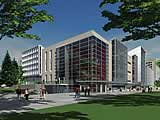 2008
2008- Official opening of the Irving K. Barber Learning Centre at UBC Vancouver (architectural rendering, right). The Learning Centre houses UBC Library collections (including an automated storage and retrieval system) and reference services, as well as the Chapman Learning Commons, the Chung Collection, and the University Archives. It also includes lecture halls, classrooms, meeting and study spaces, and seminar rooms to support UBC's interdisciplinarity and information studies programmes.
- 2009
- UBC's renewed strategic plan -- Place and Promise: The UBC Plan -- is launched in November, in a comprehensive public relations campaign utilizing print, broadcast, and digital media.
- 2010
- UBC-Vancouver is one of the host sites for the 2010 Olympic and Paralympic Winter Games. Events are held at the Doug Mitchell Thunderbird Sports Centre, and UBC Robson Square is leased as the site of the International Media Centre -- both facilities are improved and enhanced as post-Olympic legacies for the University.
The Beaty Biodiversity Museum is officially opened, bringing together UBC's various zoological and botanical collections in one facility, providing a new home for the University's biodiversity researchers, and featuring Canada’s largest blue whale skeleton exhibit.
(UBC-O) Campus doubles its land area with purchase of 103.6 hectares (256 acres) of land from the City of Kelowna.
(UBC-O) Okanagan Aboriginal Centre officially opens as an academic and cultural space for Aboriginal students. - 2011
- "Start an Evolution" fundraising campaign launched at UBC-Vancouver and UBC-Okanagan.
- 2012
- Department of Economics becomes the Vancouver School of Economics, within the Faculty of Arts.
- 2013
- (UBC-O) Arts and Sciences Centre building officially opened. The 7,800-square-metre (84,000 square feet), four-storey structure houses classrooms, research and teaching labs, offices, student commons, and two large lecture theatres.
- 2014
- UBC purchases the Iona Building from the Vancouver School of Theology for $28 million, and plans to move the Vancouver School of Economics to the facility.
» University Archives
» General History
A Brief History of the University of British Columbia
Sources
- Logan, Harry T. Tuum Est – A History of the University of British Columbia. Vancouver: The University of British Columbia, 1958.
- Okanagan College website <www.okanagan.bc.ca>
- Scrapbook for a Golden Anniversary – The University of British
Columbia Library, 1915-1965. Victoria: Morriss Printing Company
Ltd., 1965.
On-line: <www.library.ubc.ca/archives/ pdfs/history/scrapbook.pd> - UBC Digital Collections <digitalcollections.library.ubc.ca/ ubchistory.html>
- UBC Fact Book. 1992.
- UBC Okanagan website <www.ubc.ca/okanagan>
- UBC Alumni Chronicle / Trek.
- UBC Reports.
- The Ubyssey.
- Woodcock, George, and Tim Fitzharris. The University of British Columbia – A Souvenir. Toronto: Oxford University Press, 1986.
Last modified: Apr 21, 17
